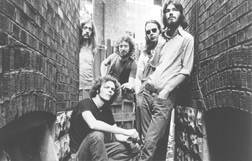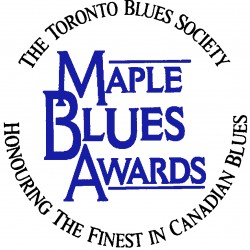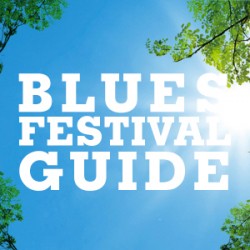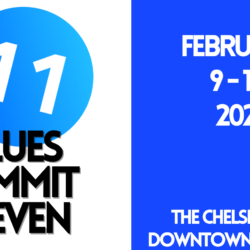CAN. BLUES?
On April 17 at 8 pm the Toronto Blues Society will present a special broadcast of radio station CKLN’s BlueSoul live from the Art Gallery of Ontario, as part of their Oh! Canada! Project, a multi-disciplinary exploration of Canadian identity coinciding with the 75th anniversary of the founding of the Group of Seven. To complement host David Barnard’s retrospective of our blues scene, TBS Executive Director Barbara Isherwood spoke to several long-time members of the Canadian blues community, to get their views on our national blues identity.
From today’s perspective there’s no denying that Canadians have taken up the blues with gusto. When did the Canadian blues scene really get started, and have we made a distinctive contribution to this North American art form? I put these questions to some folks who have been around the Canadian blues long enough to have a sense of its history and character, and learned a lot about how our blues scene has developed.
The first thing I discovered is that it’s certainly appropriate that our Oh! Canada! Project salute to Canadian blues takes place via the medium of radio, as almost everyone I spoke reiterated the importance of the U.S. airwaves in kickstarting our own scene. Norman Blakely, who as Norman B. hosted a Black music radio show on CKFH in 1967, recalls, “In the 1950s there were no places to hear blues, and no records to buy. Radio was the catalyst.” George “Houndog” Lorenz on WUFO and Randy’s Record Shop on WLAC out of Nashville brought blues to Blakely, and musicians like Dominic Traiano and Ronnie Hawkins. Blakely points out that musical definitions weren’t as rigid back then as they are today — blues and R & B were played side by side on programs featuring Black music. The folk revival of the early 1960s that began in England and spread to North America also helped the blues by exposing traditional blues artists like Muddy Waters to a wider audience.
Blakely’s memories of the early Canadian blues scene are still vivid. Enthusing about shows he saw in places like Port Dover Summer Gardens and Port Elgin Casino, he feels Canadian blues hit a high point in the early 1960s with David Clayton Thomas and the Shays, Little Caesar and the Consoles, Ritchie Knight and the Midnights, and Ronnie Hawkins and the Hawks. He remembers seeing Robbie Robertson perform Stormy Monday, and Son Richard and the Gooduns, featuring Richard Newell, as early as 1964.
Producer and keyboard player Michael Fonfara also sees the seeds for our affair with the blues being sown in Canada’s early R & B scene. His first soul band, John and Lee and the Checkmates, were fixtures on the Toronto club circuit from 1963-67. In those days, Fonfara recalls, there were a few “white soul” acts around, people like George Olliver and David Clayton-Thomas and the Shays, but no Canadian blues bands per se. Fonfara and friends relied on radio from Jacksonville, Florida and WUFO in Buffalo for source material. “We would hear songs we liked and wildly try to write down the lyrics,” laughs Fonfara. “This was before the British Invasion, when popular musical influences were either rock `n’ roll or soul music, or gospel. Our guitarist Larry Leishman was crazy about Howlin’ Wolf, Muddy Waters and John Lee Hooker.” Fonfara himself remembers being knocked out by Jimmy Reed at the old Bluenote on Yonge St. in 1964.
>Fonfara dates the start of original Canadian blues to late 1960s, coinciding with the rise of white blues acts like Paul Butterfield and Charlie Musselwhite. “Powder Blues and Downchild expanded the whole [Canadian] scene,” he says.
As to whether there’s a specific Canadian blues sound, Fonfara notes that if anything the relatively high standard of living Canadians have traditionally enjoyed makes “Canadian blues” a bit of an oxymoron. However as feeling is all important in a medium marked by its expressive capacities, Fonfara contends that if you’re sincere about what you’re doing, you can play the blues.
West Coast Blues Review editor Andy Grigg espouses a similar view, suggesting that in a blindfold test a Canadian blues act would be indistinguishable from a U.S. counterpart. To illustrate of the borderless nature of blues, Grigg notes the phenomena of Black American soul artists moving to Canada to pursue their musical careers while taking advantage of our more amenable lifestyle [in Ontario think of John Ellison and Mel Brown.] Commenting on the American influence on the “first wave” of Canadian blues artists, Grigg raises the spectre of U.S. radio again, noting that artists like Jimmy Reed and Slim Harpo had hit records on AM radio in the 1960s.
Although he doesn’t believe there is a separate Canadian sound, Grigg does think we have “bona fide artists” here, naming Back Alley John and Johnny Vee as contemporary examples. Farther back he recalls, “The first Canadian blues I heard was King Biscuit Boy [a.k.a. Richard Newell], in 1970 — “Biscuit’s Boogie”. It just floored me.” He also remembers being around for the 1971 recording session of Downchild’s first album Bootleg, recorded in basement studio of Toronto’s infamous Rochdale College.
In Toronto, TBS president Derek Andrews feels that widely acknowledged influence of the blues on all forms of 20th century popular music has been of particular significance. “During the 1960s and 70s, when many of the current Canadian popular music community were learning their craft, international blues acts such as Jimmy Reed, Muddy Waters, and Howlin’ Wolf performed regularly at clubs and coffeehouses like the Coq d’Or, the Colonial, and the Gates of Cleve. This continuous contact with touring blues artists led to the development of a popular music in which the blues is an integral aspect. You can hear it in both bands from the past, like McKenna Mendelson Mainline or Luke Gibson and present, such as Big Sugar or The Sidemen.”
Andrews also sees Canada’s position at the crossroads between Great Britian and the U. S as a shaping force. “We shared with the Brits a reverence for the roots of the blues, which surfaces in artists like Donny Walsh from the Downchild Blues Band, or John Dickie.”
References to Downchild come up again in conversation with Holger Petersen, founder of Stony Plain Records, and host of CBC Radio’s Saturday Night Blues. Although he views blues as a universal form of musical expression that doesn’t really lend itself to national tendencies, Petersen does credit Downchild’s rise in the 1970s with the development of the “tough horn sound” that came to represent Toronto blues.
He also notes that lyrically our blues bands have often had a distinctive streak, citing the decidedly Canadian content on McKenna Mendelson Mainline’s classic 1968 album Stink. And in Amos Garrett’s unique guitar tone, he hears a melding of influences from early Canadian country steel players and American R & B that has a Canadian feel.
This weaving of diverse influences into a new sound is what distinguishes Canadian blues for Joe Murphy, a twenty-five year veteran of the east coast music scene, whose own brand of zydeco/blues reflects his Acadian background.
Murphy got his professional start in 1971, playing B.B. King-influenced blues with the legendary Dutch Mason, who Holger Petersen says is usually credited with having put together the first electric Canadian blues band.
While Mason and Matt Minglewood were seminal figures for the development of the east coast blues scene, Murphy also stresses the influence of Halifax’s indigenous Black community and their music venues. In places like the Arrows Club and Club Unusual, Murphy soaked up the R & B he’d first heard on radio from Albany and Buffalo, New York — he remembers Montreal’s Trevor Payne as a regular visitor from that period. Like Norman Blakely, Murphy disagrees with the separation of blues from R & B that is prevalent today, and feels the proximity of the southern U.S. has led to an east coast sound that is a touch more soul-infused than elsewhere in Canada.
The influence of early 1960s R & B, the importance of U.S. radio, exposure to international touring acts, the folk revival — there seems to be consensus that these were the major factors shaping the formative years of our Canadian blues scene. As to whether there is any sort of distinctive Canadian sound, perhaps the most we can say at this point is that our tendency to resist the melting pot has led to a definition of blues that encompasses a diverse mix of influences. Listen to our Toronto Blues Today CD and you’ll find classic Chicago style blues appearing alongside boogie, New Orleans groove, big band blues, Mississippi Delta acoustic blues, rockabilly, swing blues, and singer-songwriter roots blues. Maybe the future of Canadian blues will include some kind of fusion that will blend our myriad influences into a new blues style, but even if our blues never passes the blindfold test, we can take pride in having achieved the highest standards in one of the world’s most expressive music forms.
– Barbara Isherwood











